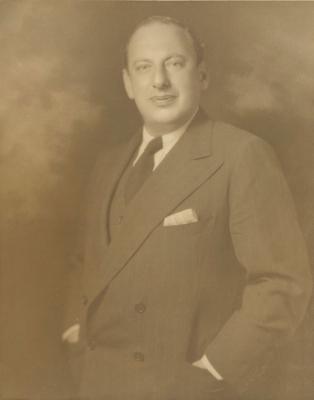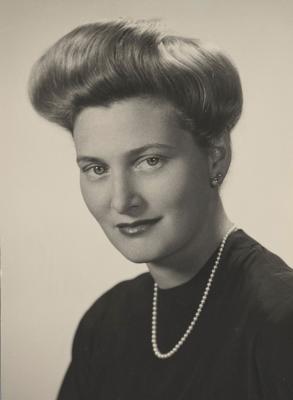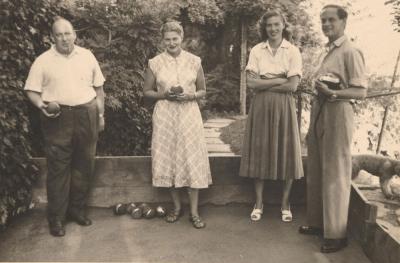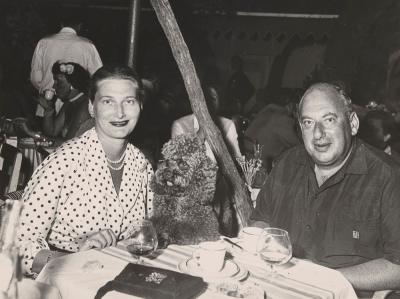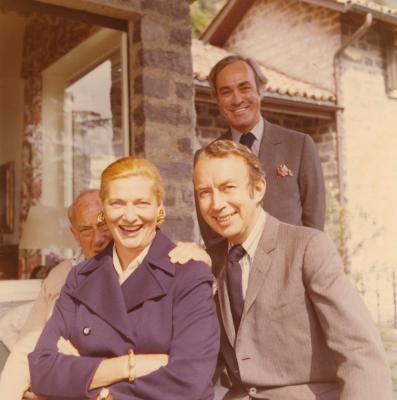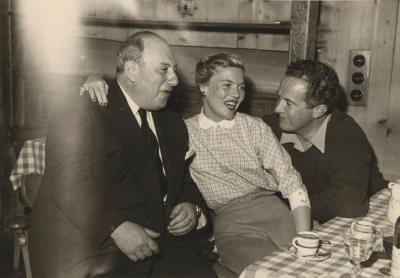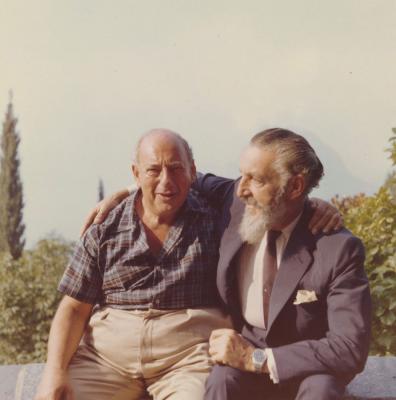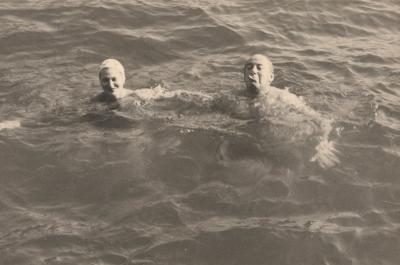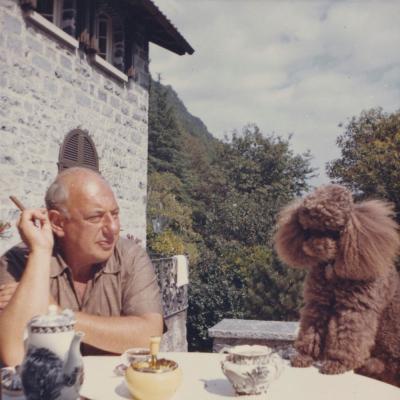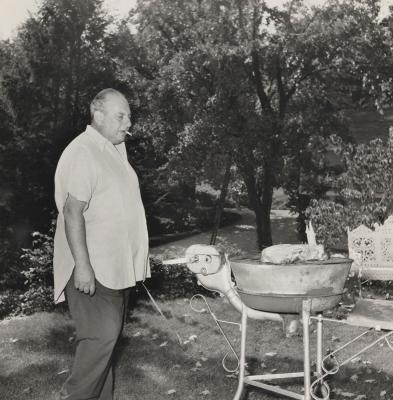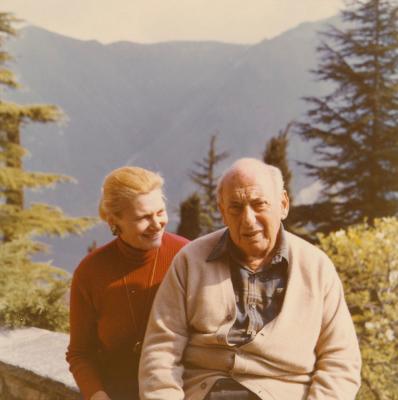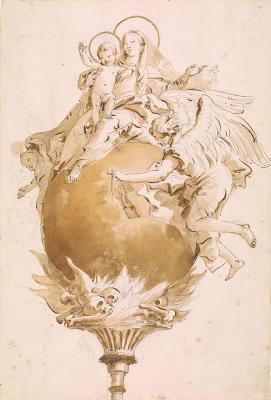
Figure 1: Giambattista Tiepolo, Virgin and Child Seated on a Globe, 1746, Pen and brown ink, with brown, ochre and violet wash, over black chalk, Gift of Lore Heinemann, in memory of her husband, Dr. Rudolf J. Heinemann, 1997.26.
Although Dr. Heinemann was not known to the general public, he was very well known to the art world for his work in sparking the sale of paintings. Very often he would buy the works himself or with a dealer for immediate resale.
New York Times, 9 February 1975
On my first day as an intern at the Morgan in the autumn of 1993, the head of the department of drawings and prints, William M. Griswold, asked me to accompany him on a trip uptown to return a group of framed drawings to Lore Heinemann. Tall and regal, Mrs. Heinemann received us at her apartment at 907 Fifth Avenue, where we rehung a selection of decoratively framed drawings by Giambattista Tiepolo in her bedroom, including the spectacular study of a mace that hung in the bed alcove (figure 1). After handing the hammer and nails back to the butler, I surreptitiously admired the Ingres drawings and paintings by Claude and Poussin. Before leaving, we had a brief chat in the sitting room, where we were served Swiss chocolates from a silver tray. Thus began my fascination with Lore Heinemann, and by extension, with her husband, Rudolf, who had died almost two decades earlier.
This November, drawings from the collection of Rudolf and Lore Heinemann will form a key component of an exhibition organized by John Marciari, Charles W. Engelhard Curator and Department Head, Drawings and Prints, and Curatorial Chair, which presents new research into the Morgan’s holdings by Giambattista and Giandomenico Tiepolo. When it comes to modern collectors of Tiepolo, Rudolf Heinemann’s name is ubiquitous, although an absence of photographs and lack of a memoir by this behind-the-scenes player has maintained a veil of mystery about his role in the world of drawings. Until now.
The son of a Munich-based art dealer, Rudolf Jakob Heinemann (1901/2–1975) studied art history in Munich and Florence and began his career as an assistant in the international art gallery founded by his grandfather (figure 2). He took over the gallery after the death of his father in 1920, before apprenticing with Wilhelm von Bode at the Kaiser Friedrich Museum in Berlin. Heinemann’s work with Bode led to a position cataloging the growing art collection of Heinrich Thyssen-Bornemisza. This promising career trajectory was altered when Heinemann was forced to leave Germany in 1935 as the situation for Jewish citizens became untenable with the rise to power of the National Socialist German Workers’ Party. He relocated to New York, becoming a naturalized American citizen in 1941. Soon thereafter he met a fellow exile, the German-born Loretta “Lore” Leiter (1914–1997) and they were married in 1947 (figure 3). They soon split their time between homes in Manhattan, Mt. Kisco, and Castagnola, a Swiss town above Lake Lugano.
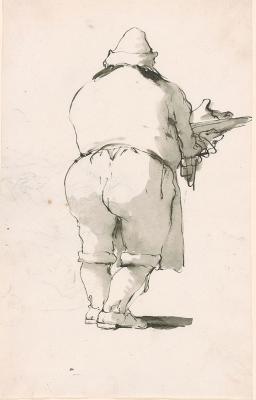
Figure 4: Giambattista Tiepolo, Caricature of a Cook, 1757–62, Pen and black ink and wash, Gift of Lore Heinemann, in memory of her husband, Dr. Rudolf J. Heinemann, 1997.25.
Rudolf Heinemann became a legend, and over the years, in the course of my work with the art dealer, collector, and Morgan Trustee Eugene Thaw (1927–2018) and others, I heard many stories about him. He seemed to be the eminence grise of the art world, especially when it came to paintings, and a very vivid personality as well. Lacking any photographs, the image in my mind’s eye of Heinemann was formed by a Tiepolo drawing which he had given his wife Lore as a gift, and which she remarked looked just like him. It is a caricature of a cook seen from behind (figure 4).
Many years later, after the death of Eugene Thaw in early 2018, a white cardboard box (that according to its label once contained Maine blueberries) was found among his estate. The box held a varied cache of black-and-white and color photographs of Rudolf and Lore Heinemann (figures 5, 6)—on vacations, at home, with curators such as William “Bill” Lieberman (1923–2005), from the Museum of Modern Art in New York, and Jacob Bean (1924-1992), the head of the drawings department at the Metropolitan Museum of Art (figure 7)—as well as with Rudolf’s most celebrated client, Hans Heinrich August Gábor (1921–2002), Baron Thyssen-Bornemisza (figure 8). Heinemann was instrumental in building the Baron’s exceptional painting and sculpture collection in Lugano, Switzerland, which eventually was moved to Madrid to form the Museo Thyssen-Bornemisza.
These photographs allowed me to visualize the elusive Heinemann and helped fill in the narrative of Heinemann’s extraordinary career. After leaving his family gallery in Munich, he established his own company in New York, Pinakos, Inc., and worked closely with several New York-based galleries, including Knoedler and Co., Arnold Seligmann Rey and Co., and Agnew’s. He was a pivotal player in international deals, especially in the world of old master paintings, connecting European sellers with American clients. Listening to art dealers who knew and worked with Heinemann, it seems as if he had a hand in a significant number of major sales from the 1940s through the 1960s, a time when American museums were actively building collections. Young dealers such as Eugene Thaw benefitted from the opportunity to take shares in major transactions which played a pivotal role in launching their careers.
Rudolf and Lore Heinemann were also avid drawing collectors. In the summer of 1973 the Heinemanns’ collection was shown at the Morgan, and over dinner after the opening, Rudolf declared that their drawings were a promised gift to the museum. This gift was hugely significant in its own right, greatly enriching the Morgan’s holdings of drawings by the Tiepolo family, but also in sparking others to follow his example. It was not long after that when the cellist Janos Scholz, after a recital celebrating the opening of a December 1973 show at the Morgan of his sixteenth-century Italian drawings, announced his collection would be given to the Morgan. At the same time, Heinemann’s protégé Eugene Thaw decided to accelerate his purchases in anticipation of exhibiting his collection at the Morgan in 1975; in the preface to the catalogue, he, too, declared his holdings were a promised gift to the Morgan.
In 1996, I had the opportunity to assist with the Tiepolo and His Circle exhibition organized at the Morgan. That same year the museum received a major gift from Lore Heinemann, in memory of Rudolf, including two albums containing sixty drawings by the Tiepolos. This was soon followed by a group of 30 Giambattista and 28 Giandomenico Tiepolo sheets given by Lore Heinemann, again in memory of Rudolf. I remember being further intrigued to learn that a large batch of the Heinemann Tiepolos were acquired in 1963 from Rudolf’s friend Tomás Harris (1908–1964), the son of a Spanish art dealer with a gallery on Bruton Street, and a likely MI5, and a confirmed MI6, agent who died in a suspicious car accident on Majorca in 1964 (figure 9).
Thanks to the box of photographs now in the Morgan’s archives, Heinemann is no longer a mysterious, behind-the-scenes impresario. These previously unseen snapshots, which capture the couple barbecuing, bathing, at parties, and playing with their dog (figures 10, 11, 12, 13), remind us of the importance of individuals, and their personalities, in the very social pursuit of art collecting.
Jennifer Tonkovich
Eugene and Clare Thaw Curator
Drawings and Prints
The Morgan Library & Museum
*I am grateful to Noel Annesley, whose remembrance of Rudolf and Lore Heinemann in the catalogue for the 22 May 1997 sale at Christie’s, New York (repeated in the 1 July 1997 Christie’s, London sale catalogue), is one of the few personal recollections of the Heinemanns in print.

